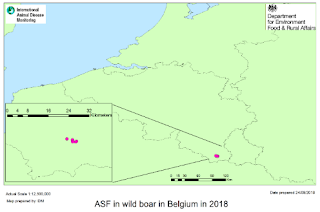#13,543
Two weeks ago, in UK: DEFRA Preliminary Assessment Of ASF Reported In Belgium, we saw the first details on the abrupt arrival of African Swine Fever to North Central Europe. Four wild boar, found dead near the border with both France and Luxembourg, were initially confirmed as infected.
Since then, additional wild boar in the region have been found dead, and have tested positive for the virus.Today DEFRA returns with an updated assessment of the situation, and the risks it poses to the pork producers in the UK and the rest of Europe.
Department of Environment, Food and Rural Affairs
Animal and Plant Health Agency
Advice Services Team - International Disease Monitoring
Updated situation assessment #1
27 September 2018
Ref: VITT/1200 ASF in wild boar in Belgium
African swine fever in wild boar in Belgium
Disease report
The Belgian Authorities have reported three new cases of ASF in wild boar since our first report (5 in total) in the Luxembourg region of Belgium (see map), close to the border with France. According to the three new disease reports, this involved a further seven wild boar altogether, and samples were tested by PCR (ADNS).
However, a total of 18 cases of ASF in wild boar found dead in the same region has been reported by Belgium’s food safety agency (AFSCA).
The source of virus incursion has not been confirmed, and investigations are continuing. The European Commission has confirmed that interim protective measures under 2002/60/EC Article 15 are in place, delineated by the border with Luxembourg and France. An Infected zone has been established (of 630 km 2 ).
Situation assessment
In the Infected Zone there are few pig farms: two commercial breeding premises (1000 animals, and 400 animals) and 5-6 small commercial premises of 50 animals (PAFF). In the infected zone, there is a ban on hunting and feeding of wild boar, collection and testing of all wild boar found dead, as well as limited access to the forest. Members of the public have been asked not to leave the main roads or to enter the forests. Additional national biosecurity measures have also been put in
place, such as a ban on pig gatherings.
At present, there is no further information on how disease has been introduced into this area. The virus isolated in Belgium is thought to belong to genotype II, which is currently circulating in Eastern Europe (Platforme). Current hypotheses include that infected meat products from ASF-infected areas has been brought and discarded along the main route through this area, but this has not yet been confirmed.
In Luxemburg, there is a surveillance zone along the border with Belgium and commercial outdoor pigs are being housed, and Belgium is facing export bans from 13 countries outside the EU, despite having no cases in domestic pigs.
Conclusions
The risk level, remains at MEDIUM. The risk of exposure to the pig population in the UK is still dependent on the level of biosecurity on pig premises and is still considered to be LOW, although the situation is being kept under review.
It is important to highlight that all products of porcine origin (including wild boar), unless processed in a certain way, is a high risk commodity from affected areas.
These products include fresh or frozen pig meat, salamis and hams, skins and bristles, germinal products, live animals, hunting trophies and any equipment which has had contact with an affected animal or the environment where they are found.
Pig keepers and veterinarians should remind themselves of the clinical signs for ASF and images and descriptions of clinical signs and pathology of ASF are provided on this link: https://www.flickr.com/photos/defragovuk/sets/72157694954571532/
We will continue to closely monitor the situation.
Authors
Dr Francesca Gauntlett
Jonathan Smith
Dr Helen Roberts
